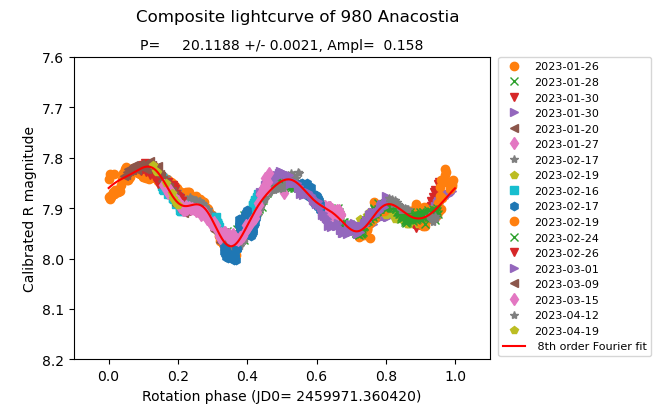Magnitude-phase curves of the Barbarian asteroids (234) Barbara, (236) Honoria, and (980) Anacostia
- 1Institute Astronomical Observatory, Faculty of Physics, Adam Mickiewicz University, Poznań, Poland (tkastr@vesta.astro.amu.edu.pl)
- 2Santa Maria de Montmagastrell Observatory, l'Urgell, Spain (MPC code B74)
Introduction
Barbarian asteroids are unique because of their wide negative branch of the polarisation phase curves. Their name comes from (234) Barbara for which such behaviour was first observed [1]. They reside in the inner part of the Main Belt and are mainly of the L taxonomic class. Since magnitude-phase curves are sensitive to the asteroid surface properties, the question arises as to whether Barbarian asteroids' magnitude-phase curves are also anomalous. To answer this, we are carrying out photometric observations of Barbarian asteroids, fitting their phase curves with the [H,G], [H, G12], and [H, G1, G2] phase functions. These parameters are then compared with those of other asteroids in search of deviations. The results for (599) Luisa and (729) Watsonia have been presented in [2]. At the conference, we will show mag-phase curves for another three Barbarians: (234) Barbara, (236) Honoria, and (980) Anacostia.
Observations and Reduction
Photometric observations were carried out using several telescopes in different observatories in the Johnson R band. For Honoria, we collected data during its 2012 opposition and for Barbara and Anacostia during the 2022 and 2023 oppositions, respectively. CCD images were reduced in a standard way, including bias, dark subtraction, and flat-field correction. The magnitudes of asteroids and standard stars were obtained with aperture photometry using the Photometry Pipeline package [3].
Results
For each asteroid, composite lightcurves from data collected during the opposition were obtained. Synodic periods were derived by a standard Fourier series fit procedure (Fig. 1). The composite lightcurves were used to correct the partial lightcurves (which did not cover all rotation phases) to the same level of maximum brightness. The magnitudes of the maxima of brightness from different nights were then plotted against the phase angle, producing mag-phase curves, which were fitted with three different phase functions (Fig. 2). This allowed us to compare the obtained G1, G2 parameters with similar parameters obtained by [4] for 127 Main Belt asteroids. The final results will be presented at the conference.

Fig. 1. Composite lightcurve of (980) Anacostia
Fig. 2. Magnitude-phase curve of (980) Anacostia, based on maxima of brightness obtained from the composite lightcurve
References
[1] Cellino, A., et al. (2006) The strange polarimetric behavior of asteroid (234) Barbara, Icarus, 180, 565
[2] Mykhailova, S., et al. (2023) What do the phase curves tell us about the Barbarian asteroids. Asteroids, Comets, Meteors Conference, Flagstaff, Arizona. LPI Contribution No. 2851, 2023, id. 2202
[3] Mommert, M. (2017) PHOTOMETRYPIPELINE: An automated pipeline for calibrated photometry, Astronomy and Computing, 18, 47
[4] Shevchenko, V. G., et al. (2016). Planetary and Space Science, 123, 101
How to cite: Kwiatkowski, T., Mykhailova, S., Podlewska-Gaca, E., Kamiński, K., Ryzhov, O., and Bosh, J. M.: Magnitude-phase curves of the Barbarian asteroids (234) Barbara, (236) Honoria, and (980) Anacostia, Europlanet Science Congress 2024, Berlin, Germany, 8–13 Sep 2024, EPSC2024-858, https://doi.org/10.5194/epsc2024-858, 2024.